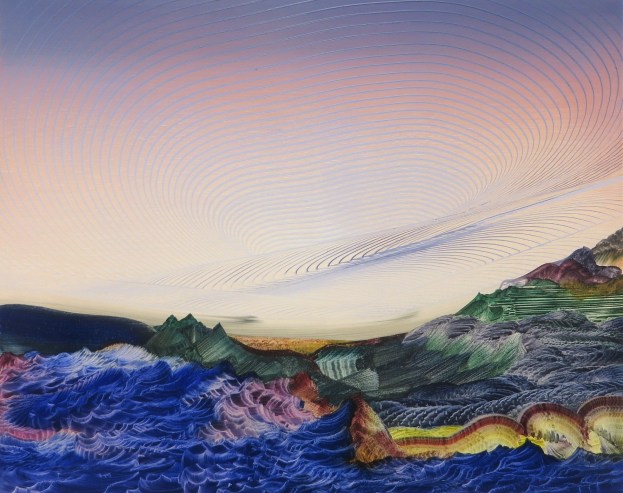
Window shopping in Chelsea and almost walking on by, I had the thought, “That looks like somebody is knocking off Elliott Green” so I went in.
Turned out it was Green himself.
Blown up, Disney-fied at first glance, yes, but with amazing passages and a complicated structure—worth seeing and talking about for sure.
Writing about Green’s paintings in 2016*, I thought his work had all the pleasure of a video game—without the violence, annoying noises and carpal tunnel. They invited a visceral physical engagement— to dart and hover.
The paintings in this show present a more remote, fantasy landscape. We are in an ideated position usually peering at them over a thick cloud. In the earlier work, there were elements of what—for want of a better way of putting it—I’ll call a Chinese use of perspective. These paintings refer to Chinese imagery directly—and it’s not just the imagery and the perspective, it’s also the jeweled inklike colors and a vocabulary of stylized calligraphic strokes.

It is certainly not a traditional language of Chinese painting techniques. One of the interesting things about the paintings is that Green has invented his own vocabulary: he combs mountains and waves that sometimes look like dragons and snakes and couples these with areas of soft pastel-colored swaths and washes. I’m somewhat repelled by the mechanical scale and pickiness of the combed areas but very attracted by the larger areas of brush strokes and washes—both close-up and at a distance.

It also gradually dawned on me as I looked at the show that these are paintings that do not have a single gestalt that can be viewed at any distance, or that even online always give the same impression. Showing simultaneously at McEnery, Brian Alfred’s work is an example of a single image that is taken in as a whole and could be blown up or reduced to any size. This approach is very dominant in contemporary painting—no point in looking around—the viewer’s eye is kept in a fixed position.

So Green is actually taking advantage of his large canvas and I admire him for it. Conjured images appear: pagodas and bridges and castles and terraced gardens in the combed areas—the mind is a wonderful thing!—and disappear when looked at closely. As I said I found the larger scale strokes and washes more interesting and they are truly magical: I think I noticed a ghostly ship flowing by in Brainflower, a simply gorgeous cloud and an icy pool is surrounded by jagged peaks:



In Ballistic Mist, a series of stepped waterfalls cut across the center and the water is glittering and splashing. There also seems to be a large soft Ming Dynasty blue tree in the upper right hand corner which miniaturizes the rest of the painting when focused upon.
Do you know Shangri-La?
It is a fiction invented by James Hilton in the 1933 book, The Lost Horizon, also a movie of the same name directed by Frank Capra in 1937. Shangri La is an almost inaccessible utopian community in the Himalayas discovered by the survivors of a plane crash, an isolated perfect place where the residents are happy and almost immortal. However, for some never totally explained reason there is an eerie tension. Also they don’t let you leave.
I haven’t thought about that book for years, but somehow this show reminded me—I googled Shangri-la and these were two images that came up:


And this information from Wikipedia:
In the ancient Tibetan scriptures, the existence of seven such places are mentioned as Nghe-Beyul Khembalung. Khembalung is one of several beyuls (hidden lands similar to Shangri-La) believed to have been created by Padmasambhava in the 9th century as idyllic, sacred places of refuge for Buddhists during times of strife (Reinhard, 1978).
I have no idea if Green dreams of idyllic refuges—in interviews, he seems to be most interested in the boundaries of representation and abstraction. But no question, these are times of strife down here in the lowlands.
—CNQ

Putting Things in Perspective: David Brody and Elliott Green, December 17, 2016

